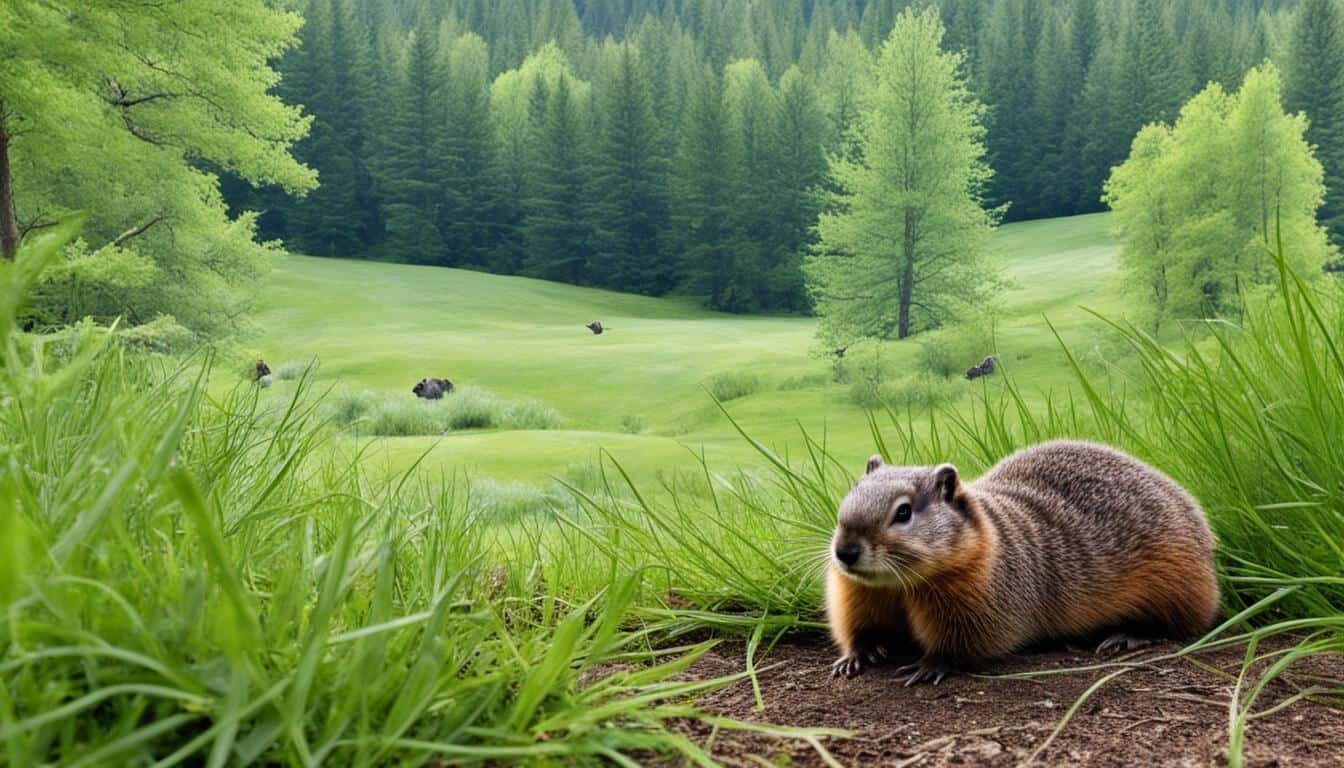Woodchucks, or groundhogs, are very good at living in different places. They can be found all over New England. This includes urban, suburban, and rural areas like fields and meadows. They also like living near woods and in spots with plenty of grass next to roads.
These animals are experts at digging burrows. Their homes are quite complex, with different rooms for sleeping and going to the bathroom. Woodchucks like to build their burrows deep into the ground, especially in dry soil. You can often see them enjoying the sun outside their burrows.
Introduction to Woodchuck Habitat Preferences
Woodchucks are known for their ability to dig impressive burrows. They choose their homes based on several key factors. These factors include their body features and behaviors. Learning about these can help us understand where these animals like to live.
Physical Characteristics of Woodchucks
Woodchucks have reddish-brown fur with gray hairs, looking darker on their faces and legs. Their short, strong legs are great for digging. They have big front teeth. These teeth help them chew and keep their teeth in good shape. This is important for their survival. These woodchuck physical traits are a big part of why they pick certain homes. They like places that are good for digging and chewing.
Behavioral Traits Influencing Habitat Choice
Woodchucks are most active in daylight. They eat most in the morning and before nightfall. They sleep during the colder months from October to March. This way of life affects where they choose to live. They look for places with lots of food like grasses and plants. They find these areas near fields and woods. They also need safe spots for their young and for sleeping in winter.
Here is a table comparing the main features of woodchucks:
| Aspect | Description |
|---|---|
| Fur | Reddish-brown with gray guard hairs and darker extremities |
| Legs | Short, muscular, adept at digging |
| Front Teeth | Large, essential for gnawing and maintaining length |
| Activity | Diurnal, active in early morning and late afternoon |
| Hibernation Period | October through March |
| Preferred Feeding Areas | Shrubby regions near fields and woodlands |
Woodlands: Natural Homes for Woodchucks
Woodchucks really like to live in woodlands. They prefer areas with mostly leafy trees and some evergreen ones. This includes places with thin trees near roads where they can find lots of food. Woodchucks make their homes under big rocks or logs. They create a big maze of tunnels and rooms underground.
Types of Woodlands Preferred
Woodchucks like living in places with many kinds of trees. This ensures they have plenty of hiding spots and food. These locations are perfect for them because they are close to roads. The roadsides offer more places to grab tasty meals.
Nesting Sites in Woodlands
Woodchucks pick their homes in woodlands with care. They choose places close to solid things like rocks or big pieces of wood. These help keep their tunnels from caving in. Their burrow homes are very important. They keep them safe from danger and are the perfect spot to raise their young.
Fields and Meadows: Ideal Woodchuck Habitats
Fields and meadows stand out as top homes for woodchucks. Why? They’re wide and full of grass, perfect for these little ones to eat. Everywhere you look, there are different plants growing. Woodchucks love this buffet.
Grassy Areas and Their Importance
Grassy places are key for woodchucks. Here, they find a variety of yummy plants like clover and alfalfa. These tasty bites help them stay strong and have lots of energy.
Feeding Behavior in Fields
Woodchucks are busy eating in fields, usually in the morning and late afternoon. They catch the best food and avoid getting too hot or becoming dinner for animals that hunt during the day.
Their digging also helps keep the soil healthy by mixing up nutrients. So, their work is important for the whole grassland, showing why these habitats are so perfect for them.
Suburban Areas: Adaptability and Challenges
Woodchucks are skilled at adapting to different places, especially in suburbs. Suburban areas bring their own set of challenges and chances. They highlight how important it is for woodchucks to choose where they live.
In suburbs, woodchucks find new food like pretty plants and veggies. They eat things that are good for them. But, they have to watch out for people and their pets. They also face the danger of getting hit by cars.
Yet, these animals find smart ways to live in suburbs safely. They handle changes in their living spaces well. This shows how they can survive and even do well in places full of people. Thus, their ability to pick the right place to live is key for their survival.
What types of habitats do woodchucks prefer?
It’s important to know what habitats woodchucks like. This helps us see how they do well in any place. They look for places with enough food and safety from other animals.
Overview of Preferred Environments
Woodchucks, or groundhogs, like specific kinds of places. These include areas near forests and in grasslands. They also live in suburban places. Such spots are good for their homes and making babies.
Seasonal Changes in Habitat Preferences
Woodchucks change what they like, depending on the time of year. In winter, they go to deep woods to stay warm. They dig their homes below the frost line. This helps them stay safe and not too cold.
In summer, woodchucks go to open places. These include grasslands and suburbs. They do this to find food easily. Such changes across seasons help woodchucks stay alright, no matter the weather.
Here’s a table comparing where woodchucks like to be in winter and summer:
| Season | Preferred Environment | Reasons for Preference |
|---|---|---|
| Winter | Deeper, wooded areas | Protection from harsh weather, below frost line |
| Summer | Grasslands, suburban areas | Easy access to food, open spaces for foraging |
By changing homes through different seasons, woodchucks always find what they need. This way, they can keep their nests safe all year.
Urban Yards: Unexpected Woodchuck Dwellings
Woodchucks are making urban and suburban areas their home more than ever. This includes backyard gardens and public green spaces. These places give the woodchucks new food options and safe spots to live.

Woodchucks like living near houses and sheds. These human-made spots help them stay safe from danger and bad weather. Also, these areas are great for finding food, which helps them survive and get used to living around people.
- Food Sources: Urban yards often contain a variety of plants, from vegetables to ornamental flowers, which can be appealing to woodchucks.
- Shelter: Structures like sheds, decks, and even fencing provide ideal shelter options, aligning with woodchuck environment choices for security.
- Water Availability: Urban areas may have more accessible water sources, adding to the desirability of these habitats.
Woodchucks’ success in urban areas shows they are tough and can adapt well. Knowing this can help if you see woodchucks in your own yard. It’s important to make wise choices to live peacefully with these animals.
Woodchuck Burrow Preferences
Woodchucks build intricate tunnels underground to meet their specific needs. Learning about their burrow choices helps us understand where they live and why. It offers insights into their lifestyle and what they require from their environment.
Structure of Woodchuck Burrows
Woodchuck burrows have a main entrance, often with a visible dirt mound. They have tunnels, chambers, and escape routes. These dwellings have different sections for nesting, storing food, and managing waste.
Ideal Soil Conditions
The type of soil is very important for woodchucks when they dig their burrows. They like dry soil that’s easy to dig and gives their tunnels support. The right soil helps their burrows stay safe and comfortable all year round.
Woodchucks in Agricultural Landscapes
Agricultural areas are both good and bad for woodchucks. These spots fit their living needs well, but also lead to trouble like damaging crops and gardens. Their adaptability shines in farmlands, yet it poses issues for farmers.
Impact on Crops and Gardens
Woodchucks eat lots of veggies, causing notable harm. Their feeding and digging can seriously harm crops. This affects plant health and production, especially for beans, peas, carrots, and lettuce.
Farmers face big challenges in managing their crops because of woodchucks.
Adaptive Behavior in Farmlands
In farmlands, woodchucks show interesting changes. They adjust their eating and burrowing habits to farm life and the seasons. This flexibility helps them live well in controlled agricultural zones, showing their toughness and constant presence.
| Aspect | Description |
|---|---|
| Diet | Woodchucks consume a variety of vegetables, grasses, and clovers, adapting their diet based on availability. |
| Burrow Locations | Burrows are often located near field edges and hedgerows to access crops while maintaining a degree of safety. |
| Seasonal Behavior | Migrating between different habitats seasonally to optimize food intake and living conditions. |
| Impact on Agriculture | Potentially significant crop damage and soil disruption due to their feeding and burrowing habits. |
Cliffs and Rock Slopes: Less Common Habitats
Woodchucks can actually make their homes in places many don’t expect. They’re known for living in woodlands, fields, and meadows. But they also adapt well to cliffs and rock slopes. These places are safer from predators. The natural cracks and places to hide in these rocks are perfect for building burrows. Inside these burrows, they find security and hide from dangers.
Rocky slopes aren’t their first choice, but they are important to woodchucks. These areas can be good for hiding or raising their young. They also provide safety when predators are close. This kind of terrain becomes especially useful when the usual places they live in are not ideal.
Woodchucks show they can do well in all kinds of places. Even in the harder-to-live-in cliffs and rocks, they succeed. They prove to be tough and smart. This makes them survive in places most don’t think they would. It shows just how wide a range of places they can live in.
FAQ
What types of habitats do woodchucks prefer?
Woodchucks like living in woodlands, fields, meadows, and sometimes, in suburbia. You can find them along grassy roadsides and in farm areas too. These places give them food and shelter they need to stay alive.
What are the physical characteristics of woodchucks that influence their habitat preferences?
They are medium-sized rodents with reddish-brown fur. Their short, strong legs help them dig well. Their big front teeth are for chewing. These features make burrowing in woodlands and dry fields easy for them.
How do behavioral traits of woodchucks influence their habitat choice?
Woodchucks are active during the day. They eat in the morning and afternoon, especially in warm months. They sleep underground in cool seasons from October to March. This lifestyle makes them like woodlands and fields filled with grass.
What types of woodlands do woodchucks prefer?
They like forests with many types of trees, like oak and hickory. Woodland edges near roads are also favored. These spots have lots of food and are great for digging their burrows near big rocks or logs.
Where do woodchucks nest in woodlands?
In woodlands, they dig burrows near big rocks and logs. These burrows are like underground homes with many tunnels and rooms. They are safe places for woodchuck families.
Why are fields and meadows ideal habitats for woodchucks?
Fields and meadows are full of food for woodchucks. The grass here grows tall with tasty plants like clover. These open areas let woodchucks look for food easily.
How do woodchucks feed in fields?
They search for food in fields early in the day and in the evening. Woodchucks eat a lot of different plants. They help the soil by digging and their eating habits. This helps the plants grow better.
How do woodchucks adapt to living in suburban areas?
In suburbs, woodchucks find new food in gardens. They must be careful of people, pets, cars, and changes in where they live.
What are the seasonal changes in woodchuck habitat preferences?
They look for deep, wooded areas in winter, making dens below the frost line. In summer, they choose more open places to find food. They make new burrows as needed, like for having babies and sleeping.
How do woodchucks make use of urban yards?
In cities, they build burrows near homes using the shelter of buildings. Urban spaces have many food choices, helping woodchucks live well in cities.
What is the structure of a typical woodchuck burrow?
A woodchuck burrow has a main entrance with a dirt mound, many rooms, and hidden ways to get out. Inside, there’s a round nest for sleeping and staying safe.
What are the ideal soil conditions for woodchuck burrows?
They like to dig in dry, well-drained dirt. This type of soil makes digging their homes easier and their homes more sturdy.
How do woodchucks impact agricultural landscapes?
They can be a problem by eating crops and gardens. But, they can change what they eat and where they live, making life easier for farmers and themselves.
Why do woodchucks sometimes choose cliffs and rock slopes as habitats?
Some woodchucks live in rocky areas to be safe and find unique places to dig. These rocky places can be a good shelter for them, especially when the weather is not so good.







